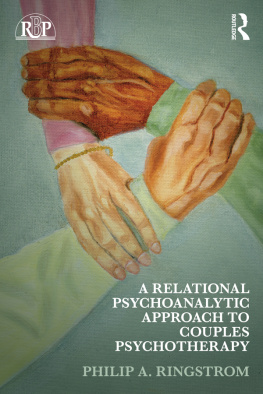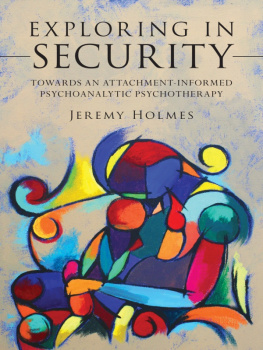CONTENTS
Copyright 2003 Alessandra Lemma
Published 2003 by John Wiley & Sons Ltd, The Atrium, Southern Gate, Chichester,
West Sussex PO19 8SQ, England
Telephone (+44) 1243 779777
The author asserts her moral rights to be identified as the author of this work in accordance with sections 77 and 78 of the Copyright, Designs and Patents Act 1988.
Email (for orders and customer service enquiries):
Visit our Home Page on www.wileyeurope.com or www.wiley.com
Reprinted January 2006
All Rights Reserved. No part of this publication may be reproduced, stored in a retrieval system or transmitted in any form or by any means, electronic, mechanical, photocopying, recording, scanning or otherwise, except under the terms of the Copyright, Designs and Patents Act 1988 or under the terms of a licence issued by the Copyright Licensing Agency Ltd, 90 Tottenham Court Road, London WIT 4LP, UK, without the permission in writing of the Publisher. Requests to the Publisher should be addressed to the Permissions Department, John Wiley & Sons Ltd, The Atrium, Southern Gate, Chichester, West Sussex PO19 8SQ, England, or emailed to , or faxed to (+44) 1243 770620.
This publication is designed to provide accurate and authoritative information in regard to the subject matter covered. It is sold on the understanding that the Publisher is not engaged in rendering professional services. If professional advice or other expert assistance is required, the services of a competent professional should be sought.
Other Wiley Editorial Offices
John Wiley & Sons Inc., 111 River Street, Hoboken, NJ 07030, USA
Jossey-Bass, 989 Market Street, San Francisco, CA 94103-1741, USA
Wiley-VCH Verlag GmbH, Boschstr. 12, D-69469 Weinheim, Germany
John Wiley & Sons Australia Ltd, 33 Park Road, Milton, Queensland 4064, Australia
John Wiley & Sons (Asia) Pte Ltd, 2 Clementi Loop #02-01, Jin Xing Distripark, Singapore 129809
John Wiley & Sons Canada Ltd, 22 Worcester Road, Etobicoke, Ontario, Canada M9W 1L1
Wiley also publishes its books in a variety of electronic formats. Some content that appears in print may not be available in electronic books.
Library of Congress Cataloging-in-Publication Data
Lemma, Alessandra.
Introduction to the practice of psychoanalytic psychotherapy / by Alessandra Lemma, p. cm.
Includes bibliographical references and index.
ISBN 0-470-84458-2 (paper : alk. paper)
1. Psychoanalysis. I. Title.
RC504 .L45 2003
616.8917dc21
2002156448
British Library Cataloguing in Publication Data
A catalogue record for this book is available from the British Library
ISBN 10: 0-470-84458-2 (PB) ISBN 13: 978-0-470-84458-8 (PB)
In doing psychoanalysis I aim at: keeping alive; keeping well, keeping awake. I aim at being myself and behaving myself. Having begun an analysis, I expect to continue with it, to survive it, and to end it. (Winnicott, 1962: 166)
ABOUT THE AUTHOR
Alessandra Lemma is a consultant clinical psychologist in the Adolescent Department at the Tavistock Clinic and in the Psychology Treatment & Assessment Service at Camden & Islington Mental Health and Social Care Trust. She is also an honorary senior lecturer in clinical psychology at University College London. She is trained as an adult psychoanalytic psychotherapist.
She is the author of the following books on psychology and psychotherapy: Starving to Live: The Paradox of Anorexia Nervosa (Central Publishing, 1994), Invitation to Psychodynamic Psychology (Whurr, 1995), Introduction to Psychopathology (Sage, 1996), Humour on the Couch (Whurr, 2000) and The Perversion of Loss: Psychoanalytic Perspectives on Trauma (Ed. with S. Levy: Whurr, in preparation).
PREFACE
This book has been largely inspired by teaching psychoanalysis to trainee clinical psychologists and other clinicians from different mental health backgrounds, who were often approaching psychoanalysis with little knowledge or experience of it. Even so, many were primed to be critical of it on the basis of prior learning or exposure to psychoanalytic interventions that had been experienced as unhelpful. I approach the subject matter in this book largely with this audience in mind, remembering some of the questions my students have put to me over the years and the criticisms they have voiced. The book is intended primarily as a practical, clinical text for workers in the mental health field who are relative newcomers to the practice of psychoanalytic therapy. It does nevertheless assume a core background in one of the mental health professions, clinical experience with patients and a degree of familiarity with the practice of psychotherapy and/or counselling more generally.
Teaching psychoanalysis has helped remind me that when we are trained psychoanalytically it is all too easy to forget that our practice is based on so much that is taken for granted, and on the idiosyncrasies of our own personal analytic experiences with training therapists and supervisors, that it is unsurprising when the newcomer to it finds the ideas confusing and the theories difficult to translate into practice. Teaching is indeed a salutary experience unless we teach the converted since it forces us to revisit cherished assumptions. It has taught me to beware the dangers of overvalued ideas, though I am sure that while reading this book you will come across several ideas with which I am all too reluctant to part company.
A word of caution is called for before embarking on this book I am a synthesiser. In this book, I have traded specificity for generalities and subtle differences in theoretical concepts for common strands between the many psychoanalytic theories that are available. It will thus probably disappoint if you are in search of sophisticated critiques of particular metapsychologies or of the philosophical underpinnings of psychoanalysis. This is not the aim of this book. Rather, my efforts are directed at developing a guiding, yet always provisional, framework for my own clinical work, based as it is on my understanding of theory and on what works in my own clinical practice. To this end, I draw on several psychoanalytic theories as I have yet to come across one model or theory that can satisfactorily account for all my analytic work.
In this book I am concerned with articulating my private clinical theory (Sandler, 1983) and its implications for technique. In some of the chapters I summarise some of the ideas that guide my work as practice guidelines. These are not intended to be in any way prescriptive but merely reflect my own attempt to make explicit how I approach my interventions, and to share the technical teachings that my own clinical supervisors have imparted to me over the years. This book pools together these experiences into a working framework that is inevitably personal and evolving. In light of this, I can make no claims that what I do and what I have written about is empirically sound, but I have endeavoured, wherever possible, to anchor my practice in the empirical research that I am familiar with.
Because this is an introductory text at the end of each chapter, I have made some suggestions for further reading which will help extend the study of the concepts and ideas presented. If approaching this book with little prior knowledge of psychoanalytic ideas, it will probably be more helpful to read it sequentially as each chapter relies on an understanding of concepts discussed in the preceding chapter.













